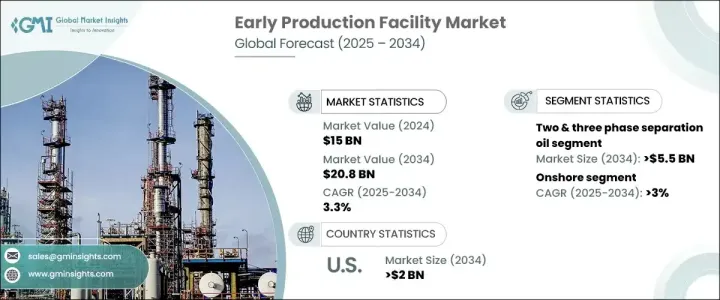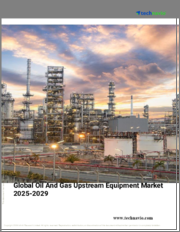
|
시장보고서
상품코드
1685109
조기 생산 설비 시장 기회, 성장 촉진요인, 산업 동향 분석, 예측(2025-2034년)Early Production Facility Market Opportunity, Growth Drivers, Industry Trend Analysis, and Forecast 2025 - 2034 |
||||||
세계의 조기 생산 설비 시장은 2024년 150억 달러에 달했고, 2025년부터 2034년까지 연평균 복합 성장률(CAGR) 3.3%를 나타낼 것으로 전망됩니다.
세계의 에너지 소비량이 증가하고, 석유 및 가스 수요가 상승을 계속하는 가운데, 동 시장은 안정된 성장을 이루고 있습니다. 생산 효율 최적화에 대한 압력이 높아짐에 따라 기업은 실시간 감시 시스템과 운영 데이터 분석을 통합하여 생산량 향상과 의사 결정의 간소화를 도모하고 있습니다. 비용 효율적이고 유연한 솔루션으로의 전환은 EPF 채택을 촉진하고 운영자는 본격적인 인프라가 완성되기 전에도 자원을 추출할 수 있습니다. 드릴링 기술과 유전 개발 전략의 개발은 EPF에 대한 투자를 가속화하고 생산주기의 단축과 자원 관리의 개선으로 이어지고 있습니다. 석유 및 가스 탐사에 대한 정부와 민간 부문의 투자는 업계 확대를 강화하고 안정적인 시장 궤도를 확실히 하고 있습니다. 게다가 지속가능성과 효율적인 자원 이용이 중시되게 됨으로써 기업은 첨단 분리·처리 기술을 도입하게 되어 시장 수요는 더욱 높아지고 있습니다.

EPF는 자본 지출을 억제하면서 원격지에서 신속한 채굴을 가능하게 함으로써 전략적 이점을 제공합니다. 사업자는 현장 상황에 따라 확장성과 적응성을 제공하는 모듈식 EPF를 활용하도록 되어 있습니다. 특히 AI, 클라우드 컴퓨팅, IoT를 통한 자동화 및 디지털화의 역할이 높아짐에 따라 설비 효율이 더욱 높아지고 있습니다. 이러한 기술은 유층 모니터링과 예지 보전을 개선하고 석유 및 가스 회사가 운영 위험을 최소화하고 생산량을 극대화하는 데 도움이 됩니다. 세계의 탄화수소 수요가 견조하게 추진되고 있는 가운데, 시장 관계자는 생산을 최적화하면서 규제 요건에 맞추기 위해 혁신적이고 친환경적인 솔루션의 개발에 주력하고 있습니다.
| 시장 범위 | |
|---|---|
| 시작 연도 | 2024년 |
| 예측 연도 | 2025-2034년 |
| 시작 금액 | 150억 달러 |
| 예측 금액 | 208억 달러 |
| CAGR | 3.3% |
2상·3상 석유 분리 분야는 에너지 가격 상승과 석유 및 가스 탐사 활동의 활성화에 의해 2034년까지 55억 달러를 창출할 것으로 예측되고 있습니다. 2상 분리 시스템은 석유 및 가스 흐름을 효율적으로 분할하여 추출을 가속화하고 시장에 신속하게 진입하고 처리 시간을 단축합니다. 한편, 3상 분리 시스템은 석유 및 가스·물을 보다 효율적으로 관리해, 수분을 많이 포함하는 유전에 이상적이기 때문에 인기를 모으고 있습니다. 이러한 첨단 분리 기술은 작업을 간소화하고 회수율을 높이고 폐기물을 최소화함으로써 석유 및 가스 회사의 수익성을 확실하게 향상시킵니다.
온쇼어 EPF 분야는 탐사 활동 증가와 임시 처리 장치, 갱정 시험 시스템, 분리 기술에 대한 요구 증가에 견인되어 2034년까지 연평균 복합 성장률(CAGR) 3%를 나타낼 것으로 예상됩니다. 온쇼어 EPF는 조기 채굴을 위한 비용 효율성과 확장성이 뛰어난 솔루션을 제공하며 기업은 인프라를 본격적으로 배포하기 전에 수익을 올릴 수 있습니다. 정부의 지원 정책과 인프라 투자는 업계 동향을 형성하고 있으며 시장 개척은 기업에게 유리한 수단이되었습니다. 효율적이고 적응성이 높은 처리장치를 추구하는 움직임은 운영의 연속성과 수익성을 보장하는 고성능 및 임시 솔루션에 대한 수요를 강화하고 있습니다.
미국의 조기 생산 설비 시장은 기술 발전과 탄화수소 분야 개발 확대에 힘입어 2034년까지 20억 달러에 달할 것으로 예측됩니다. 최첨단 드릴링 기술과 AI, 클라우드 컴퓨팅, IoT 센서의 통합이 업계를 변화시켜 실시간 저류층 모니터링 및 생산 분석을 강화하고 있습니다. 이러한 기술 혁신을 통해 석유 및 가스 회사는 채굴 효율을 최적화하고 운영 위험을 줄이고 자원 활용을 극대화할 수 있습니다. 설비 설계의 지속적인 진화와 데이터 중심의 성능 최적화가 시장 성장을 가속화하고 있습니다. 석유 및 가스 업스트림사업에 대한 설비투자 증가는 채굴방법을 개량하기 위한 광범위한 연구개발 노력과 함께 이 분야의 상승궤도를 계속 추진하고 있습니다. 디지털 전환이 업계를 재구성하는 동안 시장 관계자는 장기적인 수익성과 경쟁력을 높이기 위해 자동화와 지속가능성을 우선시하고 있습니다.
목차
제1장 조사 방법과 조사 범위
- 시장의 정의
- 기본 추정과 계산
- 예측 계산
- 데이터 소스
제2장 주요 요약
제3장 업계 인사이트
- 생태계 분석
- 규제 상황
- 업계에 미치는 영향요인
- 성장 촉진요인
- 업계의 잠재적 위험 및 과제
- 성장 가능성 분석
- Porter's Five Forces 분석
- PESTEL 분석
제4장 경쟁 구도
- 서론
- 전략 대시보드
- 혁신 및 지속가능성의 전망
제5장 시장 규모와 예측 : 구성 요소별(2021-2034년)
- 주요 동향
- 2상 및 3상 분리기
- 가스 감미화
- 가스 탈수
- 이슬점 제어 장치
- 오일 탈수, 탈염 및 가열
- 생산수 처리
- 연료 가스 처리
- 플레어 시스템
- 기타
제6장 시장 규모와 예측 : 용도별(2021-2034년)
- 주요 동향
- 온쇼어
- 오프쇼어
제7장 시장 규모와 예측 : 지역별(2021-2034년)
- 주요 동향
- 북미
- 미국
- 캐나다
- 유럽
- 프랑스
- 독일
- 이탈리아
- 네덜란드
- 러시아
- 노르웨이
- 영국
- 아시아태평양
- 중국
- 인도
- 호주
- 인도네시아
- 말레이시아
- 중동 및 아프리카
- 사우디아라비아
- UAE
- 쿠웨이트
- 터키
- 이집트
- 앙골라
- 라틴아메리카
- 브라질
- 아르헨티나
- 멕시코
제8장 기업 프로파일
- CECO Environmental
- CPPE
- EN-FAB
- Expro
- Global Process Systems
- Halliburton
- Huichuan International
- OilSERV
- Penspen
- PETECS
- Pyramid E&C
- Roska DBO
- SLB
- TAQA
- TETRA Technologies
- Weatherford
The Global Early Production Facility Market reached USD 15 billion in 2024 and is set to expand at a 3.3% CAGR from 2025 to 2034. The market is experiencing steady growth as global energy consumption rises and oil and gas demand continues to climb. With increasing pressure to optimize production efficiency, companies are integrating real-time monitoring systems and operational data analytics to enhance output and streamline decision-making. The shift toward cost-effective and flexible solutions is driving EPF adoption, allowing operators to extract resources even before full-scale infrastructure is completed. Advances in drilling technology and field development strategies are accelerating investments in EPFs, leading to shorter production cycles and improved resource management. Government and private sector investments in oil and gas exploration are reinforcing industry expansion, ensuring a stable market trajectory. Additionally, the growing emphasis on sustainability and efficient resource utilization is pushing companies to deploy advanced separation and processing technologies, further fueling market demand.

EPFs offer a strategic advantage by enabling faster extraction in remote locations while reducing capital expenditure. Operators are increasingly leveraging modular EPFs, which provide scalability and adaptability based on field conditions. The growing role of automation and digitalization, particularly through AI, cloud computing, and IoT, is further enhancing facility efficiency. These technologies are improving reservoir monitoring and predictive maintenance, helping oil and gas companies minimize operational risks and maximize output. As global hydrocarbon demand remains strong, market players are focusing on developing innovative and environmentally friendly solutions to align with regulatory requirements while optimizing production.
| Market Scope | |
|---|---|
| Start Year | 2024 |
| Forecast Year | 2025-2034 |
| Start Value | $15 billion |
| Forecast Value | $20.8 Billion |
| CAGR | 3.3% |
The two and three-phase oil separation segment is projected to generate USD 5.5 billion by 2034, driven by rising energy prices and increased oil and gas exploration activities. Two-phase separation systems expedite extraction by efficiently dividing oil and gas streams, facilitating quicker market entry and reducing processing time. Meanwhile, three-phase separation systems are gaining traction as they manage oil, gas, and water more effectively, making them ideal for oil fields with high water content. These advanced separation technologies streamline operations, improve recovery rates, and minimize waste, ensuring enhanced profitability for oil and gas companies.
The onshore EPF segment is set to grow at a 3% CAGR through 2034, driven by increasing exploration activities and the rising need for temporary processing units, well testing systems, and separation technologies. Onshore EPFs provide a cost-effective and scalable solution for early extraction, enabling companies to generate revenue before full infrastructure deployment. Supportive government policies and infrastructure investments are shaping industry trends, making onshore development a lucrative avenue for market players. The push for efficient and adaptable processing equipment is reinforcing the demand for high-performance yet temporary solutions that ensure operational continuity and profitability.
The US early production facility market is forecasted to reach USD 2 billion by 2034, bolstered by technological advancements and the expansion of hydrocarbon field development. Cutting-edge drilling techniques and the integration of AI, cloud computing, and IoT sensors are transforming the industry, enhancing real-time reservoir monitoring and production analysis. These innovations enable oil and gas companies to optimize extraction efficiency, reduce operational risks, and maximize resource utilization. The continuous evolution of facility designs and data-driven performance optimization is accelerating market growth. Increasing capital investments in upstream oil and gas activities, coupled with extensive R&D efforts to refine extraction methods, continue to fuel the sector's upward trajectory. As digital transformation reshapes the industry, market players are prioritizing automation and sustainability to drive long-term profitability and competitiveness.
Table of Contents
Chapter 1 Methodology & Scope
- 1.1 Market definitions
- 1.2 Base estimates & calculations
- 1.3 Forecast calculation
- 1.4 Data sources
- 1.4.1 Primary
- 1.4.2 Secondary
- 1.4.2.1 Paid
- 1.4.2.2 Public
Chapter 2 Executive Summary
- 2.1 Industry synopsis, 2021 - 2034
Chapter 3 Industry Insights
- 3.1 Industry ecosystem analysis
- 3.2 Regulatory landscape
- 3.3 Industry impact forces
- 3.3.1 Growth drivers
- 3.3.2 Industry pitfalls & challenges
- 3.4 Growth potential analysis
- 3.5 Porter's analysis
- 3.5.1 Bargaining power of suppliers
- 3.5.2 Bargaining power of buyers
- 3.5.3 Threat of new entrants
- 3.5.4 Threat of substitutes
- 3.6 PESTEL analysis
Chapter 4 Competitive Landscape, 2024
- 4.1 Introduction
- 4.2 Strategic dashboard
- 4.3 Innovation & sustainability landscape
Chapter 5 Market Size and Forecast, By Component, 2021 – 2034 (USD Million)
- 5.1 Key trends
- 5.2 Two & three phase separator
- 5.3 Gas sweetening
- 5.4 Gas dehydration
- 5.5 Dew point control units
- 5.6 Oil dehydration, desalting, and heating
- 5.7 Produced water treatment
- 5.8 Fuel gas processing
- 5.9 Flare systems
- 5.10 Others
Chapter 6 Market Size and Forecast, By Application, 2021 – 2034 (USD Million)
- 6.1 Key trends
- 6.2 Onshore
- 6.3 Offshore
Chapter 7 Market Size and Forecast, By Region, 2021 – 2034 (USD Million)
- 7.1 Key trends
- 7.2 North America
- 7.2.1 U.S.
- 7.2.2 Canada
- 7.3 Europe
- 7.3.1 France
- 7.3.2 Germany
- 7.3.3 Italy
- 7.3.4 Netherlands
- 7.3.5 Russia
- 7.3.6 Norway
- 7.3.7 UK
- 7.4 Asia Pacific
- 7.4.1 China
- 7.4.2 India
- 7.4.3 Australia
- 7.4.4 Indonesia
- 7.4.5 Malaysia
- 7.5 Middle East & Africa
- 7.5.1 Saudi Arabia
- 7.5.2 UAE
- 7.5.3 Kuwait
- 7.5.4 Turkey
- 7.5.5 Egypt
- 7.5.6 Angola
- 7.6 Latin America
- 7.6.1 Brazil
- 7.6.2 Argentina
- 7.6.3 Mexico
Chapter 8 Company Profiles
- 8.1 CECO Environmental
- 8.2 CPPE
- 8.3 EN-FAB
- 8.4 Expro
- 8.5 Global Process Systems
- 8.6 Halliburton
- 8.7 Huichuan International
- 8.8 OilSERV
- 8.9 Penspen
- 8.10 PETECS
- 8.11 Pyramid E&C
- 8.12 Roska DBO
- 8.13 SLB
- 8.14 TAQA
- 8.15 TETRA Technologies
- 8.16 Weatherford




















